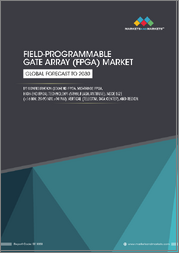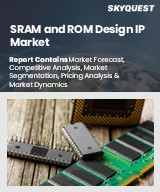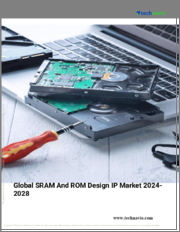
|
시장보고서
상품코드
1675814
SRAM 및 ROM 설계 IP시장 : 유형별, 지역별(2025-2033년)SRAM and ROM Design IP Market Report by Type (SRAM (Static Random Access Memory), ROM (Read-Only Memory)), and Region 2025-2033 |
||||||
SRAM 및 ROM 설계 IP 시장 세계 시장 규모는 2024년 6억 6,510만 달러에 달했습니다. 향후 IMARC Group은 2033년까지 7억 5,010만 달러에 달할 것이며, 2025-2033년 연평균 성장률(CAGR)은 1.51%를 기록할 것으로 전망하고 있습니다. 중소기업 및 대기업의 클라우드 스토리지 솔루션 채택 확대, 반도체 제조 기술 발전, 대용량 데이터를 처리하는 데이터센터의 수요 증가 등이 시장을 이끄는 주요 요인으로 꼽힙니다.
SRAM(Static Random Access Memory) 설계 IP는 전자 시스템용으로 설계된 메모리 기술입니다. 전원이 공급되는 한 데이터를 유지하는 휘발성 메모리로, 2개의 크로스커플드 인버터를 통해 4개의 트랜지스터에 1비트 데이터를 저장합니다. 고속 동작이 가능하며, 데이터 리프레시가 필요하지 않습니다. 마이크로프로세서 등 고속 애플리케이션의 캐시 메모리로 널리 사용되고 있습니다. 반면, ROM(읽기 전용 메모리) 설계 IP는 미리 프로그래밍된 데이터를 저장하는 비휘발성 메모리로, RAM(랜덤 액세스 메모리)에 비해 테스트가 용이하고 신뢰성이 뛰어나며, 읽기 전용으로 변경이 불가능한 데이터와 정보를 저장합니다. 또한, 펌웨어, 부트코드, 기타 전자 시스템의 고정 데이터 저장에도 이용됩니다.
SRAM 및 ROM 설계 IP 시장 동향:
현재 전 세계 중소기업 및 대기업의 클라우드 스토리지 솔루션 채택이 증가하고 있는 것은 시장 성장을 촉진하는 중요한 요인 중 하나입니다. 여기에 사물인터넷(IoT) 기기 사용 증가로 인한 효율적인 저장 및 처리에 대한 수요 증가가 시장에 긍정적인 영향을 미치고 있습니다. 또한, 저전력 소비 및 고밀도 스토리지 솔루션의 채택이 증가하고 있는 것도 시장 성장을 촉진하고 있습니다. 이와는 별도로 대량의 데이터를 원활하게 처리하기 위한 데이터센터의 수요 증가가 시장 성장을 촉진하고 있습니다. 또한, 성능 향상과 전력 소비 감소를 위한 노드 크기의 소형화 및 혁신적인 메모리 아키텍처와 같은 반도체 제조의 기술 발전도 시장 성장에 기여하고 있습니다. 또한, 고성능 메모리 솔루션에 대한 수요 증가에 따라 SRAM 및 ROM 설계 IP의 채택이 증가하고 있는 점도 시장 전망을 밝게 하고 있습니다. 이에 따라 DRAM(Dynamic Random Access Memory)보다 빠른 SRAM의 채택이 증가하면서 시장 성장을 견인하고 있습니다. 또한, 첨단 무선 네트워크의 도입으로 인한 SRAM 및 ROM 설계 IP에 대한 수요 증가는 업계 투자자들에게 유리한 성장 기회를 제공하고 있습니다.
본 보고서에서 다루는 주요 질문
- 세계 SRAM 및 ROM 설계 IP 시장은 지금까지 어떻게 성장해 왔을까?
- 세계 SRAM 및 ROM 설계 IP 시장의 촉진요인, 억제요인, 기회요인은 무엇인가?
- 각 촉진요인, 억제요인, 기회가 세계 SRAM 및 ROM 설계 IP 시장에 미치는 영향은 무엇인가?
- 주요 지역 시장은?
- 가장 매력적인 SRAM 및 ROM 설계 IP 시장은 어느 국가인가?
- 유형별 시장 분석은?
- 시장에서 가장 매력적인 SRAM 및 ROM 설계 IP 유형은?
- 세계 SRAM 및 ROM 설계 IP 시장의 경쟁 구도는?
- 세계 SRAM 및 ROM 설계 IP 시장의 주요 플레이어/기업은?
목차
제1장 서문
제2장 조사 범위와 조사 방법
- 조사 목적
- 이해관계자
- 데이터 소스
- 1차 정보
- 2차 정보
- 시장 추정
- 상향식 접근
- 하향식 접근
- 조사 방법
제3장 주요 요약
제4장 소개
- 개요
- 주요 업계 동향
제5장 세계의 SRAM 및 ROM 설계 IP시장
- 시장 개요
- 시장 실적
- COVID-19의 영향
- 시장 예측
제6장 시장 내역 : 유형별
- SRAM
- ROM
제7장 시장 내역 : 지역별
- 북미
- 미국
- 캐나다
- 아시아태평양
- 중국
- 일본
- 인도
- 한국
- 호주
- 인도네시아
- 기타
- 유럽
- 독일
- 프랑스
- 영국
- 이탈리아
- 스페인
- 러시아
- 기타
- 라틴아메리카
- 브라질
- 멕시코
- 기타
- 중동 및 아프리카
- 시장 내역 : 국가별
제8장 촉진요인, 억제요인, 기회
- 개요
- 성장 촉진요인
- 성장 억제요인
- 기회
제9장 밸류체인 분석
제10장 Porter's Five Forces 분석
- 개요
- 구매자의 교섭력
- 공급 기업의 교섭력
- 경쟁 정도
- 신규 참여업체의 위협
- 대체품의 위협
제11장 가격 분석
제12장 경쟁 구도
- 시장 구조
- 주요 기업
- 주요 기업 개요
- Advanced Micro Devices Inc.
- Dolphin Technology Inc.
- Renesas Electronics Corporation
- Surecore Limited
- Synopsys Inc.
The global SRAM and ROM design IP market size reached USD 665.1 Million in 2024. Looking forward, IMARC Group expects the market to reach USD 750.1 Million by 2033, exhibiting a growth rate (CAGR) of 1.51% during 2025-2033. The growing adoption of cloud storage solutions among small and large-scale enterprises, technological advancements in semiconductor manufacturing, and rising demand in data centers to handle huge data represent some of the key factors driving the market.
Static random-access memory (SRAM) design intellectual property (IP) is a memory technology that is designed for electronic systems. It is a volatile memory that stores data as long as power is supplied. It stores a bit of data on four transistors through two cross-coupled inverters. It can be operated at a higher speed and does not require data to be refreshed. It is widely utilized as cache memory in microprocessors and other high-speed applications. On the other hand, read-only memory (ROM) design IP is a non-volatile memory that contains pre-programmed data. It is easy to test and offers more reliability as compared to random access memory (RAM). It stores data and information that can only be read and cannot be modified. Besides this, it is utilized for storing firmware, boot code, and other fixed data in electronic systems.
SRAM and ROM Design IP Market Trends:
At present, the increasing adoption of cloud storage solutions among small and large-scale enterprises across the globe represents one of the key factors impelling the growth of the market. Besides this, the growing demand for efficient storage and processing due to the increasing utilization of the Internet of Things (IoT) devices is positively influencing the market. Additionally, the rising adoption of low-power and high-density storage solutions is bolstering the growth of the market. Apart from this, the increasing demand in data centers to handle a large amount of data smoothly is propelling the growth of the market. In addition, technological advancements in semiconductor manufacturing, such as smaller node sizes and innovative memory architectures, to provide enhanced performance and reduce power consumption is contributing to the growth of the market. Moreover, the growing adoption of SRAM and ROM design IP on account of the increasing demand for high-performance memory solutions is offering a favorable market outlook. In line with this, the rising employment of SRAM, as it is faster than dynamic random-access memory (DRAM), is supporting the growth of the market. Furthermore, the increasing demand for SRAM and ROM design IP due to the introduction of advanced wireless networks is offering lucrative growth opportunities to industry investors.
Key Market Segmentation:
Type Insights:
- SRAM (Static Random Access Memory)
- ROM (Read-Only Memory)
Regional Insights:
- North America
- United States
- Canada
- Asia Pacific
- China
- Japan
- India
- South Korea
- Australia
- Indonesia
- Others
- Europe
- Germany
- France
- United Kingdom
- Italy
- Spain
- Russia
- Others
- Latin America
- Brazil
- Mexico
- Others
- Middle East and Africa
- The report has also provided a comprehensive analysis of all the major regional markets, which include North America (the United States and Canada); Asia Pacific (China, Japan, India, South Korea, Australia, Indonesia, and others); Europe (Germany, France, the United Kingdom, Italy, Spain, Russia, and others); Latin America (Brazil, Mexico, and others); and the Middle East and Africa. According to the report, Asia Pacific was the largest market for SRAM and ROM design IP. Some of the factors driving the Asia Pacific SRAM and ROM design IP market included the growing use of electronic products, rising adoption of memory solutions among various enterprises, presence of key market players, etc.
Competitive Landscape:
- The report has also provided a comprehensive analysis of the competitive landscape in the global SRAM and ROM design IP market. Detailed profiles of all major companies have been provided. Some of the companies covered include Advanced Micro Devices Inc., Dolphin Technology Inc., Renesas Electronics Corporation, Surecore Limited, Synopsys Inc., etc. Kindly note that this only represents a partial list of companies, and the complete list has been provided in the report.
Key Questions Answered in This Report:
- How has the global SRAM and ROM design IP market performed so far, and how will it perform in the coming years?
- What are the drivers, restraints, and opportunities in the global SRAM and ROM design IP market?
- What is the impact of each driver, restraint, and opportunity on the global SRAM and ROM design IP market?
- What are the key regional markets?
- Which countries represent the most attractive SRAM and ROM design IP market?
- What is the breakup of the market based on the type?
- Which is the most attractive type in the SRAM and ROM design IP market?
- What is the competitive structure of the global SRAM and ROM design IP market?
- Who are the key players/companies in the global SRAM and ROM design IP market?
Table of Contents
1 Preface
2 Scope and Methodology
- 2.1 Objectives of the Study
- 2.2 Stakeholders
- 2.3 Data Sources
- 2.3.1 Primary Sources
- 2.3.2 Secondary Sources
- 2.4 Market Estimation
- 2.4.1 Bottom-Up Approach
- 2.4.2 Top-Down Approach
- 2.5 Forecasting Methodology
3 Executive Summary
4 Introduction
- 4.1 Overview
- 4.2 Key Industry Trends
5 Global SRAM and ROM Design IP Market
- 5.1 Market Overview
- 5.2 Market Performance
- 5.3 Impact of COVID-19
- 5.4 Market Forecast
6 Market Breakup by Type
- 6.1 SRAM (Static Random Access Memory)
- 6.1.1 Market Trends
- 6.1.2 Market Forecast
- 6.2 ROM (Read-Only Memory)
- 6.2.1 Market Trends
- 6.2.2 Market Forecast
7 Market Breakup by Region
- 7.1 North America
- 7.1.1 United States
- 7.1.1.1 Market Trends
- 7.1.1.2 Market Forecast
- 7.1.2 Canada
- 7.1.2.1 Market Trends
- 7.1.2.2 Market Forecast
- 7.1.1 United States
- 7.2 Asia-Pacific
- 7.2.1 China
- 7.2.1.1 Market Trends
- 7.2.1.2 Market Forecast
- 7.2.2 Japan
- 7.2.2.1 Market Trends
- 7.2.2.2 Market Forecast
- 7.2.3 India
- 7.2.3.1 Market Trends
- 7.2.3.2 Market Forecast
- 7.2.4 South Korea
- 7.2.4.1 Market Trends
- 7.2.4.2 Market Forecast
- 7.2.5 Australia
- 7.2.5.1 Market Trends
- 7.2.5.2 Market Forecast
- 7.2.6 Indonesia
- 7.2.6.1 Market Trends
- 7.2.6.2 Market Forecast
- 7.2.7 Others
- 7.2.7.1 Market Trends
- 7.2.7.2 Market Forecast
- 7.2.1 China
- 7.3 Europe
- 7.3.1 Germany
- 7.3.1.1 Market Trends
- 7.3.1.2 Market Forecast
- 7.3.2 France
- 7.3.2.1 Market Trends
- 7.3.2.2 Market Forecast
- 7.3.3 United Kingdom
- 7.3.3.1 Market Trends
- 7.3.3.2 Market Forecast
- 7.3.4 Italy
- 7.3.4.1 Market Trends
- 7.3.4.2 Market Forecast
- 7.3.5 Spain
- 7.3.5.1 Market Trends
- 7.3.5.2 Market Forecast
- 7.3.6 Russia
- 7.3.6.1 Market Trends
- 7.3.6.2 Market Forecast
- 7.3.7 Others
- 7.3.7.1 Market Trends
- 7.3.7.2 Market Forecast
- 7.3.1 Germany
- 7.4 Latin America
- 7.4.1 Brazil
- 7.4.1.1 Market Trends
- 7.4.1.2 Market Forecast
- 7.4.2 Mexico
- 7.4.2.1 Market Trends
- 7.4.2.2 Market Forecast
- 7.4.3 Others
- 7.4.3.1 Market Trends
- 7.4.3.2 Market Forecast
- 7.4.1 Brazil
- 7.5 Middle East and Africa
- 7.5.1 Market Trends
- 7.5.2 Market Breakup by Country
- 7.5.3 Market Forecast
8 Drivers, Restraints, and Opportunities
- 8.1 Overview
- 8.2 Drivers
- 8.3 Restraints
- 8.4 Opportunities
9 Value Chain Analysis
10 Porters Five Forces Analysis
- 10.1 Overview
- 10.2 Bargaining Power of Buyers
- 10.3 Bargaining Power of Suppliers
- 10.4 Degree of Competition
- 10.5 Threat of New Entrants
- 10.6 Threat of Substitutes
11 Price Analysis
12 Competitive Landscape
- 12.1 Market Structure
- 12.2 Key Players
- 12.3 Profiles of Key Players
- 12.3.1 Advanced Micro Devices Inc.
- 12.3.1.1 Company Overview
- 12.3.1.2 Product Portfolio
- 12.3.1.3 Financials
- 12.3.1.4 SWOT Analysis
- 12.3.2 Dolphin Technology Inc.
- 12.3.2.1 Company Overview
- 12.3.2.2 Product Portfolio
- 12.3.3 Renesas Electronics Corporation
- 12.3.3.1 Company Overview
- 12.3.3.2 Product Portfolio
- 12.3.3.3 Financials
- 12.3.3.4 SWOT Analysis
- 12.3.4 Surecore Limited
- 12.3.4.1 Company Overview
- 12.3.4.2 Product Portfolio
- 12.3.5 Synopsys Inc.
- 12.3.5.1 Company Overview
- 12.3.5.2 Product Portfolio
- 12.3.5.3 Financials
- 12.3.5.4 SWOT Analysis
- 12.3.1 Advanced Micro Devices Inc.
Kindly note that this only represents a partial list of companies, and the complete list has been provided in the report.



















